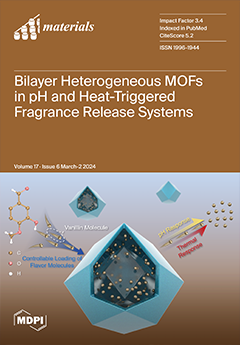It is well known that the annealing process plays a key role in tuning the properties of Fe-based amorphous soft magnetic alloys. However, the optimal annealing process for a particular amorphous alloy is often difficult to determine. Here, Fe
81.4B
13.2C
[...] Read more.
It is well known that the annealing process plays a key role in tuning the properties of Fe-based amorphous soft magnetic alloys. However, the optimal annealing process for a particular amorphous alloy is often difficult to determine. Here, Fe
81.4B
13.2C
2.8Si
1.8P
0.8 and Fe
82.2B
12.4C
2.8Si
1.8P
0.8 amorphous alloys (denoted as Fe
81.4 and Fe
82.2) were prepared to systematically study the effects of the annealing temperature and time on the soft magnetic properties. The results show that the optimum annealing temperature ranges of the Fe
81.4 and Fe
82.2 amorphous alloys were 623 K to 653 K and 593 K to 623 K, and their coercivity (
Hc) values were only 2.0–2.5 A/m and 1.3–2.7 A/m, respectively. Furthermore, a characteristic temperature
Tai was obtained to guide the choosing of the annealing temperature at which the
dBs/
dT begins to decrease rapidly. Based on the theory of spontaneous magnetization, the relationship between
Tai and the optimum annealing temperature ranges was analyzed. When the annealing temperature was higher than
Tai, the effect of the internal magnetic field generated by spontaneous magnetization on the relaxation behavior was significantly reduced, and the alloys exhibited excellent soft magnetic properties. It is worth indicating that when annealed at 603 K (slightly higher than
Tai), the Fe
82.2 amorphous alloys exhibited excellent and stable soft magnetic properties even if annealed for a long time. The
Hc of Fe
82.2B
12.4C
2.8Si
1.8P
0.8 amorphous alloys was only 1.9 A/m when annealed at 603 K for 330 min. This value of
Tai is expected to provide a suggestion for the proper annealing temperature of other amorphous soft magnetic alloys.
Full article






